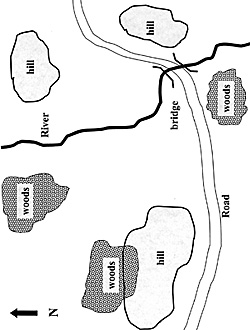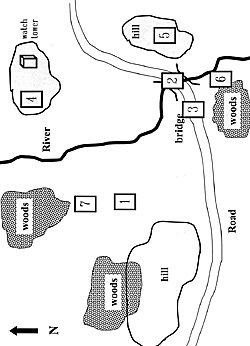 The Great March East is a fairly light hearted fantasy wargame scenario, in which the player aims lead his Goblin Horde across a hostile battlefield to the Eastern provinces beyond. Perhaps not completely surprisingly not everyone thinks that this migration is "a good thing" and a loose alliance of opposing forces stands in the way of the goblins.
The Great March East is a fairly light hearted fantasy wargame scenario, in which the player aims lead his Goblin Horde across a hostile battlefield to the Eastern provinces beyond. Perhaps not completely surprisingly not everyone thinks that this migration is "a good thing" and a loose alliance of opposing forces stands in the way of the goblins.
A battle map is provided, as are army lists for both sides, these have been designed for Games Workshop's Warhammer. I've put the points value of each set of troops in brackets after the unit name, so if you don't have the right figures just substitute something similar of the same points value. It may seem that these are quite large forces for a GW game, well just recall that you don't have to use GW's 25mm figures - there are cheaper alternatives. Ral Partha, for example, produce some exquisite figures (their Elves are - to me at least - still, the definitive Tolkien style Elves) at, fraction (around a half) of GW prices. I don't know why, but that's the way it is! Also, Warhammer (suitably tweaked for move distances/firing ranges) works fine with 15min figures, and even 6mm (although this does mean using paperwork to track casualties if using stands of figures).
The first thing to do is consult Map 1, which shows the table top to be fought over. Decide on you initial dispositions on the Western (left hand) board edge, and give the individual units their written orders. The overall objective is to move as many units off the eastern board edge as is possible.
Unit 1: General & bodyguard of 9 Orcs on war boars. The Orcs carry a hand weapon, and have light armour and a shield, one bears Gork's war banner (unit +1 strength when charging) (365 points). The General (296 points) is similarly equipped, and has the crown of command (leadership increased to 10) and Morgor the Mangler (user strikes first, + 1 Weapon Skill, Strength and Toughness. Only magic armour gets an armour save).
Unit 2: 19 Orcs with heavy armour, shield and spear (189 points). Orc Champion similarly equipped and also bearing a sword of might (+1 strength) (57 points).
Unit 3: 19 Orcs, light armour, shield, sword and javelins (181 points). Orc Champion similarly equipped and also bearing a blade of leaping copper (+1 attacks) (62 points).
Unit 4: 9 Goblin wolf riders - hand weapon, spear, shield (99 points) with a similarly equipped champion (46 points), also bearing a shield of ptolos (armour save of 6+/1+ vs missile attacks)
Unit 5: Unit of 3 trolls (325 points) led by an Orc champion with light armour, shield and spear (67 points), and bearing the morning star of Fracasse (+2s bonus I st round of combat, each wound inflicts 2 wounds)
Unit 6: 20 Orcs, heavy armour and double handed weapon (2 10 points) led by a similarly equipped champion (58 points), bearing a parrying blade (one enemy has 1 less attack) and an enchanted shield (armour save 5+)
Unit 7: 20 goblins with short bows, light armour and shield (100 points) led by a similarly equipped champion (52 points) bearing a bone blade (each wound inflicts D3 wounds).
Goblins are not the noted master brains of any fantasy world. This thought, coupled with re-read rather a lot of P.G. Wodehouse, led to the following twist. Once the unit dispositions and orders have been decided on roll on the following table for each unit, to determine the capability of the commander. Each unit leader can only be rolled for once - if you get a duplicate then re-roll.
Die Roll : Unit Commander's name & abilities
- 1: Jeeves - understands the orders perfectly, and may modify the
unit's orders twice in the game
2: Ooffy Prosser - lose every fourth word from the unit's orders
3: Bingo Biffin - lose every 6th word from the unit's orders
4: Madeline Bassett - understands the orders, but, roll on the Madeline Bassett table at the start of each turn
5: Rosemary M. Banks - understands all the orders
6: Bertie Wooster - lose all of the orders after the fifteenth word.
Madeline Bassett Table
- 1: Carries out orders
2: moves the unit at ftill speed directly away from the nearest melee
3: moves unit towards the nearest wood at full speed
4: moves unit towards the river at full speed
5: moves unit towards the summit of the nearest hill
6: unit stands still and contemplates the clouds
So, for example, a unit of goblins have been assigned the orders: Advance to the woods north of the road, pass through these and make for the river. Look for a crossing. If the way is clear proceed the east, otherwise engage the lightest armoured enemy.
The unit rolls and finds out that it's commander is Ooffy Prosser. The unit now has the orders advance to the north of the pass through these make for the look for a if the way is clear proceed east otherwise engage lightest armoured enemy.
Interpret the new orders for the unit as if you were a nit-picky opponent in the final round of a knock-out competition (!) So, for example, this may lead Ooffy Prosser's unit to march to the pass between the hills on the western edge of the board, go through the pass then die roll 1-3 move north of the hills and engage an enemy or 4-6 move south of the hills and engage an enemy, unless there are none there in which case continue heading east.
If in any turn a unit commander is within 6" of the army general then 1 word of the original order may be restored. The good news is that the Orc/Goblin animosity rules can be ignored for this game (there's enough to contend with without infighting).
As mentioned above there is a general tendency to move to the East. Along the way units may encounter the enemy, and your orders may not be overly clear on what to do in this situation (especially if the unit is led by one of the lesser brains of the party). Roll for each unit commander to determine their attitude to the enemy in these situations.
- 1: Fierce as a lion - if orders do not prohibit then attack all available enemy
2-4: a chap doesn't avoid a fair fight - if orders do not prohibit attack all, except betters
5: discretion is the better part of what-not: Attack only inferiors
6: Combat only slows the great march east, show the enemy your heels and keep going lad.
 The preliminaries now being over the board can be set up as per Map 2 - which is subtly difference from Map 1, and shows the dispositions of enemy units. The River may, or may not, be fordable. When a unit tries to ford the river roll a die and consult the following table:
The preliminaries now being over the board can be set up as per Map 2 - which is subtly difference from Map 1, and shows the dispositions of enemy units. The River may, or may not, be fordable. When a unit tries to ford the river roll a die and consult the following table:
- 1-3: 12 inch stretch of the river (centred on the unit) is fordable
4: river not fordable for 12 inches centred on the unit, but a small bridge (1 figure wide) has been found
5-6: river not fordable for 12 inches centred on the unit
Enemy Troop List
The enemy units are positioned as shown on Map 2. They are generally following a defensive battleplan - so units 2 - 3 will try and hold the bridge, units 4 and 6 will cover the river for fording units, but support the troops on the bridge if required. Unit 5 is a reserve to be used as required, units 1 and 7 will try to prevent enemy troops reaching the river, but will also follow up retreating troops as required.
Unit 1: Human champion, with light armour, shield and sword leading 19 men armed with halbards wearing light armour (204 points)
Unit 2: 10 heavy cavalry - heavy armour, shield, lance mounted on warhorses, with army general human lord - heavy armour, shield, and star lance (+3s bonus in charge, no armour save) mountrd on armoured warhorse. One of the cavalry carries the army banner - dread banner (unit causes fear and is immune to fear) (471 points)
Unit 3: 20 wood elf archers (includes standard bearer), no armour, long bow (220 points)
Unit 4: human infantry - 10 with short bow, 10 with double handed sword, all have light armour (180 points)
Unit 5: 10 human light cavalry - horse, light armour, bows, and 9 high elf heavy infantry - with spears, heavy armour and shield. Cavalry have a banner and a musician, elves have a banner. The Elves are led by a champion wearing armour of brilliance (armour save 3+, foes suffer -2 to hit) (421 points)
Unit 6: Dwarf heavy spearmen, 19 dwarves in heavy armour, with spears (includes banner and musician) led by dwarf hero in heavy armour armed with a sword of might (+1 strength) (355 points)
Unit 7: 10 Human cavalry, light armour, shield and sword (160 points)
On both sides all special characters must remain attached to their original unit, and suffer the same fate as that unit (so if a unit of goblins routs, then they take their leader with them). Otherwise the game could descend into just a series of brawls between champions as their units flee the table!
I deliberately left out all spell casters, mainly because I think their effect can become too important a battle, I also haven't really thought about how to solo play them. Maybe someone else has?
Back to Table of Contents -- Lone Warrior #132
Back to Lone Warrior List of Issues
Back to MagWeb Magazine List
© Copyright 2000 by Solo Wargamers Association.
This article appears in MagWeb (Magazine Web) on the Internet World Wide Web.
Other military history articles and gaming articles are available at http://www.magweb.com
